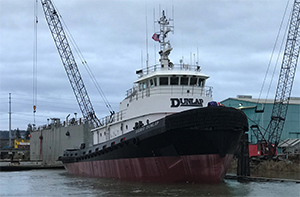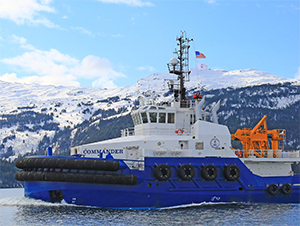When it comes to tugboat design and technology, some people believe North American operators lag behind trendsetters in Asia, Europe or Australia. Yet the world’s most powerful ASD ship handling tugboats are operating in the United States, not in Rotterdam or Sydney or Singapore.
The 140-by-54-foot Commander arrived in Valdez, Alaska, this spring. Starting July 1, it will escort tankers in Prince William Sound for Alyeska Pipeline Service Co. It is the first of five identical escort vessels built and owned by Edison Chouest Offshore.
Virtually everything about this tug class, based on the Damen ASD 4517 design, stands out. It has 12,336 total hp from twin Caterpillar C280-16 Tier 4 engines turning 157.5-inch controllable props in Rolls-Royce z-drives. They are capable of 15 knots ahead and more than 150 tons of direct bollard pull.
“I can tell you the larger Alyeska tugs are the biggest- and strongest-ever built ASD escort and mooring assist tugs in the world,” said Jan W. van Hogerwou, Damen’s senior vice president for North America.
These tugs also have some of the most advanced remote monitoring of mechanical and electrical components. Land-based crews will be able to detect component and onboard system failures before the crew knows, he said. “Downtime of these highly advanced tugs will therefore be reduced to the absolute minimum whilst safety of the crew has evolved to the highest standard.”
Edison Chouest Offshore (ECO) takes over escort service in Prince William Sound from Crowley Maritime on July 1. The Louisiana company will hold the escort contract for 10 years, and is building nine new tugs for the project — including four new 102.5-foot, 6,008-hp general purpose tugboats. These vessels will tow oil-response barges and assist docking tankers.
Elrington is the lead boat in the smaller class, which has Cat 3516E Tier 4 engines and Rolls-Royce z-drives with 102-inch props. It boasts 72.5 tons of bollard pull. ECO also is supplying four oil spill response barges.
In addition to the z-drives, Rolls-Royce provided the fore and aft winches on all nine new tugs.
“ECO’s Commander, Elrington and Latouche tugs have arrived in Prince William Sound from the Gulf of Mexico, and all nine tugs will have arrived by late June,” said Lisa Matlock, outreach coordinator for the Prince William Sound Regional Citizens’ Advisory Council. “These purpose-built vessels are a powerful, unified fleet that can transfer crew between them.”
Two escort tugs will accompany the loaded tankers during outbound transits from Valdez. One will be tethered to the ships from the Valdez Marine Terminal beyond the Valdez Narrows, according to Alyeska Pipeline Service.
“The tugs stay within a quarter-mile during a tanker escort to make sure every tanker remains within visual sight and easy range for response,” said Kate Dugan, an Alyeska Pipeline Service spokesperson. “In an emergency, the escort vessels might be called upon to stop the tanker, counter any undesired deviation in course or take the tanker under tow.”
Commander and its sister tugs are equipped with berthing for 12 people, FFVI firefighting capabilities, oil spill detection equipment and an infrared camera. Elrington and its siblings also have berthing for 12 and oil spill detection equipment. Two will have firefighting equipment.
Tom Barrett, president of Alyeska Pipeline Service Co., said its incoming crews have spent the spring training in Alaskan waters, in simulators and on board the new tugs as they arrive. He predicted a seamless transition to the ECO vessels.
Susan Buchanan contributed reporting.
 |
|
Sigrid Dunlap undergoing final outfitting at Hansen Boat Co. in Everett, Wash. |
|
Dunlap Towing/Matt Branscome |
Sigrid Dunlap
Dunlap Towing was preparing in spring 2018 to take delivery of an oceangoing tugboat built by Hansen Boat Co. of Everett, Wash. Hockema Whalen Myers Associates provided plans for the vessel.
Dunlap Towing plans to use the 121.5-by-38-foot Sigrid Dunlap to tow barges between Seattle and Honolulu. The tug is ABS A1 classed and SOLAS rated. Sigrid is based on designs from Phyllis Dunlap, built in 2001. However, it has extensive upgrades and is more powerful than its predecessor.
“Nearly every system was reworked to incorporate the latest regulatory requirements and vendor equipment,” naval architect Michael Whalen said.
Propulsion comes from twin 2,675-hp Caterpillar C-175 Tier 3 engines turning 120-inch, three-bladed, stainless-steel props through Reintjes WAF 1173 reduction gears. Sigrid Dunlap also has a Nautican integrated propulsion unit. Electrical power comes from Caterpillar C7.1 gensets each producing 125 kW.
The tug has a Markey double-drum TDSDS-36 towing winch spooled with 3,100 feet of 2.25-inch wire and 2,200 feet of 1.25-inch towing wire in separate drums. The hawser winch is a Markey DESW-32-20 electric drive unit.
The wheelhouse has Furuno radars, electronic chart display, radios and GMDSS. Simrad provided the autopilot system and gyrocompass, and Jastram supplied the steering system.
There are seven total staterooms on Sigrid Dunlap, two of which are single berths and five are doubles. Total crew will be six people. The tug has capacity for 152,000 gallons of diesel, 1,800 gallons each of lube and hydraulic oil, and 2,000 gallons of potable water.
Mount Baker/Mount Drum
Nichols Brothers Boat Builders delivered the tugboats Mount Baker and Mount Drum to Kirby Offshore Marine. Jensen Maritime Consultants designed the 120-by-35-foot vessels.
The lead vessel, Mount Baker, left Nichols’ Whidbey Island, Wash., shipyard in May 2017, followed by Mount Drum in November 2017. The ocean towing tugs are capable of 8 knots while towing a loaded barge. Bollard pull exceeds 69 tons.
Propulsion comes from twin Caterpillar 3516C engines generating 2,447 hp at 1,600 rpm. Those mains turn Nautican fixed-pitch props inside nozzles through Reintjes WAF 873 reduction gears. Caterpillar C7.1 generators provide electrical power.
On deck, the tugs have a Markey TESD-34 tow winch, a Markey CEW-60 electric capstan and a Smith Berger tow pin. Fendering from Schuyler Cos. protects the hulls forward and aft.
New York/Cape Fear
Vane Brothers of Baltimore took delivery in April 2018 of the 4,200-hp New York, the sixth of eight Elizabeth Anne-class model bow tugs ordered from St. Johns Ship Building in Palatka, Fla. The late naval architect Frank Basile designed the vessels.
Like its sister vessels, the 100-by-34-foot New York is outfitted with twin Caterpillar 3516 Tier 3 engines generating 2,100 hp each. Two 99-kW John Deere PowerTech 4045 generators provide electrical power. A third Deere 4045 unit powers the tug’s Intercontinental DD200 towing winch.
Simrad electronics and navigation equipment populate the lower and upper wheelhouses. The tug operates with a five-person crew but has berthing for seven.
As of spring 2018, New York was undergoing final outfitting. It will primarily tow petroleum barges along the East Coast. The final two tugs of the eight-vessel order, named Jacksonville and Charleston, are due in late 2018 and early 2019, respectively.
Vane Brothers also will take delivery in mid-2018 of the 3,000-hp Sassafras-class tug Cape Fear. Chesapeake Shipbuilding is building the vessel.
Kāpena Jack Young
Young Brothers Limited expects to take delivery on June 15 of Kāpena Jack Young, the first of four new oceangoing tugboats. Damen designed the 123-by-36.5-foot tug built by Conrad Shipyard in Morgan City, La.
Main propulsion is provided by twin GE 8L250MDC Tier 4 engines generating 6,000 total hp at 900 rpm. The engines turn 126-inch fixed-pitch props through Optima-type nozzles and Reintjes WAF 3455 gears at a 5.523:1 ratio. Three Caterpillar C7.1 generators provide electrical power.
Kāpena Jack Young and its sister tugs will have Markey TESD-34 100-hp electric towing winches and Smith Berger towing pins and shark jaws. Bollard pull is 80 tons and operating speeds are estimated at 12.5 knots light.
Wheelhouse electronics consist of Furuno navigation equipment, Simrad autopilot, Sailor VHF radios and KVH satellite system. The tug has berthing for 10 in six cabins.
The new tugs will tow cargo barges between the Hawaiian islands. They will replace four of seven existing tugs in the company’s fleet and pair with existing barges delivered within the last decade.
On the Horizon
• Shaver Transportation of Portland, Ore., is building Samantha S, a versatile 8,400-hp tractor tug, at nearby Diversified Marine. The 110-by-42-foot tug will have twin GE Tier 4 engines producing 4,200 hp each and Rolls-Royce US 305 z-drives. Delivery is expected in fall 2018.
• Western Towboat of Seattle is building the 4,000-hp harbor tug Mariner at its Seattle shipyard. The 80-foot vessel is based on Western’s Westrac design with modifications by Capt. Russ Shrewsbury. Delivery is expected in early 2019.
• Construction also is underway on Hull 6502 at Great Lakes Shipyard in Cleveland. The vessel is the second in the 65-foot, 2,000-hp Great Lakes class based on the Damen Stan 1907 ICE Class design. The lead vessel in the series, Cleveland, entered service last summer.
• Gulf Island Fabrication is building a 118-by-45-foot ice-class tugboat for the Saint Lawrence Seaway Development Corp. based on a Robert Allan Ltd. TundRA 3600 design. The tug will be equipped with Tier 4 engines. Delivery is expected in summer 2019.
• Gulf Island also won a contract to build four Suderman & Young Towing Co. tugboats based on the Robert Allan Ltd. Z-Tech 30-80 design.
• Harley Marine Services of Seattle has ordered two 100-by-34-foot oceangoing tugs from Conrad Shipyards. The new vessels, expected in late 2018 and early 2019, will have Caterpillar Tier 4 engines and Cat gensets. Entech Designs provided the vessel plans.
• Foss Maritime has partnered with Damen Shipyards on a tugboat series based on the Damen ASD 2813 design. Foss plans to build the tugs at its Rainier, Ore., shipyard. The company will keep some of the new tugs and sell others. The first deliveries are expected in 2019.
• Baydelta Maritime has ordered a 100-foot z-drive tugboat with a Rolls-Royce hybrid propulsion system paired with Caterpillar Tier 3 engines. Jensen Maritime Consultants designed the tug, and Nichols Brothers Boat Builders is building it. Delivery is slated for early 2019.
• Washburn & Doughty of East Boothbay, Maine, is building two 93-by-38-foot hybrid z-drive tugs for Harbor Docking and Towing of Lake Charles, La. Caterpillar will provide the Tier 4 engines, hybrid system, generators and z-drives. Delivery dates for the new tugs have not been disclosed.

